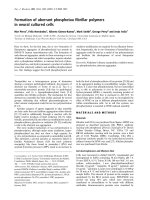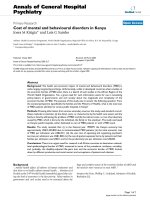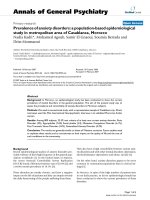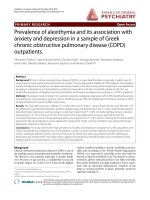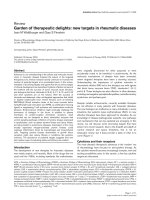Báo cáo y học: "Prevalence of accessory deep peroneal nerve in referred patients to an electrodiagnostic medicine clinic" pdf
Bạn đang xem bản rút gọn của tài liệu. Xem và tải ngay bản đầy đủ của tài liệu tại đây (3.54 MB, 5 trang )
RESEA R C H ART I C L E Open Access
Prevalence of accessory deep peroneal nerve
in referred patients to an electrodiagnostic
medicine clinic
Seyed Mansoor Rayegani
1*
, Elham Daneshtalab
2
, Mohamad Hasan Bahrami
1
, Dariush Eliaspour
1
,
Seyed Ahmad Raeissadat
1
, Sajjad Rezaei
1
and Marzieh Babaee
1
Abstract
Background: Accessory Deep Peroneal Nerve (ADPN) is an anatomic variation that can potentially cause
disturbance in electrodiagnostic studies. This anomaly could be detected by nerve conduction studies. There are
no recen t updates about prevalence of this anatomic variation. Electrodiagnostic medicine clinic is the best
environment for detecting presence and prevalence of this nerve, so present study enrolled.
Materials & Methods: In this cross sectional descriptive study that take place from March 2009 to July 2010, 230
cases comprising 460 legs referred for electrodiagnostic studies of upper limbs problems participated in the study.
Compound muscle action potential (CMAP) and Nerve conduction Velocity (NCV) of Deep Peroneal Nerve (DPN)
were measured by using EMG machine by stimulating DPN at knee, ankle and lateral malleolous areas accordingly,
with recording from extensor digitorum brevis m uscle. Results were analyzed and conclusion made.
Results: The study population included 120 females (52%) and 110 (47%) males with mean age of 42.1 ± 13.5
years. ADPN was detected in 28 patients (12%). Among them,10(17.9%) had bilateral ADPN and in remained 18
cases (82.1%) APN was unilateral. In 8 patients there was no recorded CMAP from EDB by proximal and distal
stimulation implying EDB agenesis. Gender distribution was similar which means half of the cases (14 patients)
belonged to each gender.
Conclusion: The prevalence of ADPN in this study was 12.2%, (17.9% bilateral and 82.1% unilateral).
Introduction
Accessory Deep Peroneal Nerve (ADPN) is an anatomic
variation which can potentially disturb electrodaignostic
studies [1,2]. This nerve is separated from Superficial
Peroneal Nerve (SPN) and then turns around lateral
malleolus to inner vate all or part of Extensor Digitorum
Brevis(EDB)[3,4] (figure 1).
If this anomaly exists among patients with peroneal
nerve lesion, atypical presentations could be seen in
their electrodiagnostic study (EDX) [5]. In case of Deep
Peronel Nerve (DPN ) lesion, denervation in all of DPN
innervated muscles could be seen except for EDB [2,4].
In case of Superficial Peroneal Nerve (SPN) lesion at
distal part of leg there is only impaired sensory SPN
response, however in case of APN variation, denervation
of EDB is also present. In addition, lesions in proximal
part of SPN causes usually denervation in peroneus
longus and peroneus b revis muscles plus finding of
impaired sensory response of SPN. In case of APN these
findings are accompanied by denervation potentials in
EDB [6 ,7]. The above mentioned findings that are con-
sequence of presence of ADPN could errornously label
complete type of Deep Peroneal Nerve lesion as incom-
plete one and also in case of pure Superficial Peroneal
nerve lesion as Common Peroneal Nerve lesion.
This anomaly should be considered whenever there is
peroneal nerve injury with above mentioned unusual
presentations [8]. Anomaly is suspected whenever elicit-
ing the CMAP (Compound Muscle Action Potential)
response of EDB following peroneal nerve stimulation at
* Correspondence:
1
Physical Medicine and Rehabilitation Research Center, Shahid Beheshti
Medical University, Tehran, Iran
Full list of author information is available at the end of the article
Rayegani et al. Journal of Brachial Plexus and Peripheral Nerve Injury 2011, 6:3
/>JOURNAL OF BRACHIAL PLEXUS AND
PERIPHERAL NERVE INJURY
© 2011 Rayegani et al; licensee BioMe d Central Ltd. This is an Open Access article distributed under the terms of the Creative
Commons Attribution License ( which permits unrest ricted use, distribution, and
reproduction in any medium, pr ovided the original work is properly cited.
anterior of ankle would result either in small or no
response [8,9]. Lack of denervation in EDB in case of
DPN injury at ankle is also seen in this anatomic varia-
tion [10]. According to different studies, ADPN preva-
lence is estimated to be 13 to 25 percent [6,11]. Our
studygoalistodeterminetheprevalenceofthisnerve
variation in our population and reemphasizing attention
to this anatomic variation in routine electrodiagnostic
studies.
Methods & Materials
In this descriptive cross sectional study 230 referred
patients (460 legs) that was r eferred for EDX evaluation
of upper limbs problems in Shohada EDX center,
located at department of Physi cal medicine and Rehabi-
litation, after explaining the procedure and taking verba l
consent were enrolled in the study. Lack of neurological
complaints and normal neurologic examinatio n of lower
limbs were inclusion criteria for the cases. CMAP
responses of DPN by proximal and distal stimulation
were recorded from EDB muscle. Surface stimulation
electrode using constant current was used for stimula-
tion and surface bar recording electrode for recording.
Proximal stimulation at knee region around fibular head
and recording the response via EDB was done at first,
distal stimulation was done at anterior of ankle and
then shifted to lateral malleolus, while recording site
was the same i.e EDB muscle. All responses were saved
for analysis(figure 1). In cases in which CMAP responses
were not recorded by distal (ankle) stimulation (figure 2),
and/or its amplitude was lesser than proximal stimula-
tion (figure 3) and instead by lateral malleolus stimula-
tion the response was elicited, presence of APN was
confirmed. In conditions that there was no recorded
CMAP from EDB by proximal and distal stimulations
(ant. of ankle and lateral malleolus), concentric EMG
needle was used for recording of the CMAP response.
Absence of the response even by this technique and lack
of EMG activity by requesting patients to extend their
toes at metatarsophalangeal joints without any denerva-
tion potentials, were assumed for agenesis of EDB. All
tests were performed or directly supervised by a physia-
trist attending. Toennis Neuro-screen model EMG
machine was used for the study. Information including
age, gender, and results of Nerve Conduction Velocity
(NCV), Latency, CMAP of proximal and distal s timula-
tion were recorded for analysis.
Results
120 females (52%) and 110 males (48%) with mean age
of 42.11 ± 13 years (ranging from 15 to 65 years) were
participated in the study. Mean of NCV, and CMAP
amplitude by distal and proximal stimulation of DPN in
patients without ADPN were rec orded and a nalyzed.
(Additional f ile 1: Table S1 and Figure 4). 28 patients
(12%) including 14 male and 14 female were detected to
have ADPN. 10 patients had bilateral and remained 18
patients unilateral ADPN. 8 patients had complete
ADPN without recor ded response from EDB by ankle
stimulation and remained 20 patients had incomplet e
Figure 1 Anatomy of ADPN. This figure shows graphic anatomic course of ADPN.
Rayegani et al. Journal of Brachial Plexus and Peripheral Nerve Injury 2011, 6:3
/>Page 2 of 5
type of ADPN with recording the response from EDB by
both ankle and lateral malleolus stimulation. (Additional
file 2: Graph 1)
In 8 patients there were no recorded EDB responses by
proximal and distal stimulation via surface and needle
recording and there was no EMG activity and palpable
EDB muscle mass by voluntary extension of toes at
metatarsophalangeal joints.
Discussion
Presence of Accessory Deep Peroneal Nerve (ADPN)
may complicate electrodiagnostic and clinical features of
peroneal nerve palsy including Common Peroneal, Deep
Peroneal & Superficial peroneal parts. So that presence
of ADPN could errornously label complete type of Deep
Peroneal Nerve lesion as incomplete one and also in
case of pure Superficial Peroneal nerve lesion as Com-
mon Peroneal Nerve lesion.
ADPN is a branch of superficial peroneal nerve, that
has sensory and motor branches. The sensory branch
innervates ankle joint, tendons and ligaments, and
motor branch to peroneus longus and EDB [4]. The
nerve can sometimes be entrapped at ankle and cause
pain and discomfort at foot and ankle [11].
Our results indicate that, preval ence of ADPN is 12% .
We found that 35% of 28 patients (10 patients) had
bilateral type of A DPN. In our study there is no differ-
ence between female and male in distribution of APN.
Other issue that was detected and explained in our
study is detection of EDB agenes is that was not shown
and mentioned in other studies [2,12].
Prevalence of ADPN was calculated up to 28% in
other studies [13,14]. Mathis and et al. according to
electrophysiological study of DPN and APN in 200
healthy subjects(400legs) shown 13.5% prevalence of
APN. This finding is simil ar to our results [11]. Kou-
dah and et al. studied the presence of accessory deep
peroneal nerve on Japanese cadavers and reported that
it was consistently present in 100% of speciments [15].
But Hasegawa et al. based on electrophysiological
studies in Japanese persons demonstrated 17-28%
prevalence of accessory deep peroneal nerve [16].
Bhardwaj and et al. shown 33.3% prevalence of ADPN
in Indian cadavers [12]. This difference could be due
Figure 2 NCS record of incomplete ADPN. this graph is showing characters of CMAP record of incomplete type of ADPN.
Rayegani et al. Journal of Brachial Plexus and Peripheral Nerve Injury 2011, 6:3
/>Page 3 of 5
Figure 3 NCS record of complete ADPN. this graph is showing characters of CMAP record of complete type of ADPN.
Figure 4 NCS record of DPN without ADPN. this graph is showing characters of CMAP record of DPN without ADPN.
Rayegani et al. Journal of Brachial Plexus and Peripheral Nerve Injury 2011, 6:3
/>Page 4 of 5
to some genetic issues and/or techniques used that
needs further studies to be confirmed. Also Kayal
andetal.describedthisdifference” the reported
evidence is higher in studies that routinely applied
stimulation behind the lateral malleolus during
the performance of peroneal mo tor conduction stu-
dies” [2].
Marciniak study indicated 74% of patients had bilat-
eral type of APN [17], which is more than our result
(35%). Bilateral ADPN in this study was higher in males
while in another studies it was higher in females [10,18].
No difference was found in our study.
Owaski and et al described the higher prevalence of
APN in relative of healthy control group, reflecting
autosomal dominant transmission [6]. Studies show that,
the inheritance pattern of the accessory deep peroneal
nerve is an autosomal dominant trait [7].
The most important parameter for detecting ADPN
is comparing distal to proximal CMAP of EDB. In
cases that distal CMAP w as smaller than proximal sti-
mulation, and/or no CMAP detected by distal “ankle”
stimulation, this variation should be suspected. M athis
and et al. explained same result. They compared elec-
trophysiological parameters in patients with and with-
out ADPN. Their study showed a significant higher
DPN motor potential area ratio (distal/pro ximal ratio)
in subjects without APN [11].
The finding of no recorded EDB CMAP by distal and
proximal stimulation of DPN and also lack of EMG
activities and palpable EDB muscle mass by voluntary
extension of toes at metatarsophalangeal joints, that was
detected in 8 cases, was assumed as agenesis of EDB.
This was not m entioned it in othe r studies. Owsiak and
et al.found that, ADPN may innervate greater part of
the EDB[6]. Ubogu explained about complete innerva-
tions of EDB by APN in his study without mention to
the possibility of EDB agenesis [13].
Conclusion
This study demonstrated that ADPN prevalence in
referred patients fo r e lectrodiagnostic study of upper
limbs to our clinic was 12%. There were also 8
patients with signs of EDB agenesis. This study
showed again the significant prevalence of this ana-
tomic variation and its potential role in complicating
the electrodiagnostic interpretation of peroneal nerve
study. There is no difference between male and
female in our study.
Additional material
Additional file 1: Table S1: NCS of cases without ADPN. presentation
of NCS of cases without ADPN by NCV, amplitude and gender
distribution.
Additional file 2: graph 1: total numbers of cases. all cases are shown
in graphic presentation including total, with and without ADPN and EDB
agenesis
Author details
1
Physical Medicine and Rehabilitation Research Center, Shahid Beheshti
Medical University, Tehran, Iran.
2
Department of Physical Medicine and
Rehabilitation, Shohada Medical Center, Tehran, Iran.
Authors’ contributions
SMR proposed the topic of study, performed some of tests, designed the
article, translated to English and supervise the work. ED performed some of
tests, prepared the figures. MHB performed some of tests, reviewed articl es.
DE performed some of tests, SAR performed some of tests. SR participated
in the design of the study. MB participated in the design of the study. All
authors read and approved the final manuscript.
Competing interests
The authors declare that they have no competing interests.
Received: 15 September 2010 Accepted: 8 July 2011
Published: 8 July 2011
References
1. Dumitru D, Amato AA, Zwarts MJ: Electrodiagnostic medicine Hanley & Belfus
San Antonio, Texas; 2002.
2. Kayal R, Katirji B: In Atypical deep peroneal neuropathy in the setting of an
accessory deep peroneal nerve. Volume 40. Muscle & Nerve; 2009:(2):313-315.
3. DeLisa JA: manul of nerve conduction study clinical nerouphysiology. 3
edition. new york: raven press; 1994.
4. Knoll AN: Nerve Anatomy and Entrapment Neuropathies of the Lower 2010.
5. Masakado Y: Clinical neurophysiology in the diagnosis of peroneal nerve
palsy. The Keio Journal of Medicine 2008, 57(2):84-89.
6. Owsiak S, Kostera-Pruszczyk A: Accessory deep peroneal nerve-a clinically
significant anomaly? Neurologia i neurochirurgia polska 2008, 42(2):112-115.
7. Kuruvilla A: Accessory deep peroneal nerve. Neurology India 2004, 52(1):135-135.
8. Andresen B, Wertsch J, Stewart W: Anterior tarsal tunnel syndrome.
Archives of physical medicine and rehabilitation 1992, 73(11):1112-1117.
9. Krause KH, Witt T, Ross A: The anterior tarsal tunnel syndrome. Journal of
neurology 1977, 217(1):67-74.
10. Posa HNRM: deep peroneal sensory neuropathy. Muscle & Nerve 1992,
15:745-746.
11. Mathis S: Study of accessory deep peroneal nerve motor conduction in a
population of healthy subjects. Neurophysiologie Clinique/Clinical
Neurophysiology 2011, 214-215.
12. Bhardwaj AK: Anatomic variations of superficial peroneal nerve: clinical
implications of a cadaver study. Italian Journal of Anatomy and
Embryology 2010, 115(3):223-228.
13. Ubogu EE: Complete innervation of extensor digitorum brevis by
accessory peroneal nerve. Neuromuscular Disorders 2005, 15(8):562-564.
14. Murad H, Neal P, Katirji B: Total innervation of the extensor digitorum
brevis by the accessory deep peroneal nerve. European Journal of
Neurology 1999, 6(3):371-373.
15. Kudoh H, Sakai T, Horiguchi M: The consistent presence of the human
accessory deep peroneal nerve. Journal of anatomy 1999, 194(01):101-108.
16. Hasegawa OMS, Wada N: innervation patterrn to the extensor digirtorum
brevis by deep peroneal nerve and accessory deep peroneal nerve. No
To Shinkei 2001, 53:453-456.
17. Marciniak C: Practice parameter: Utility of electrodiagnostic techniques in
evaluating patients with suspected peroneal neuropathy: An evidence
based review. Muscle & Nerve 2005, 31(4):520-527.
18. Posa HNRM: nerve conduction studies of the medial branch of deep
peroneal nerve. Muscle & Nerve 1990, 13:862.
doi:10.1186/1749-7221-6-3
Cite this article as: Rayegani et al.: Prevalence of accessory deep
peroneal nerve in referred patients to an electrodiagnostic medicine
clinic. Journal of Brachial Plexus and Peripheral Nerve Injury 2011 6:3.
Rayegani et al. Journal of Brachial Plexus and Peripheral Nerve Injury 2011, 6:3
/>Page 5 of 5




